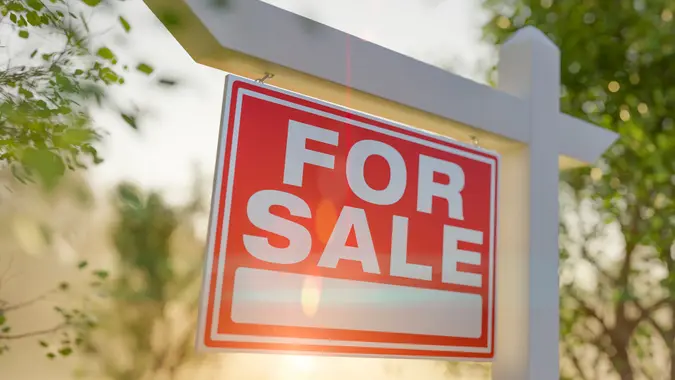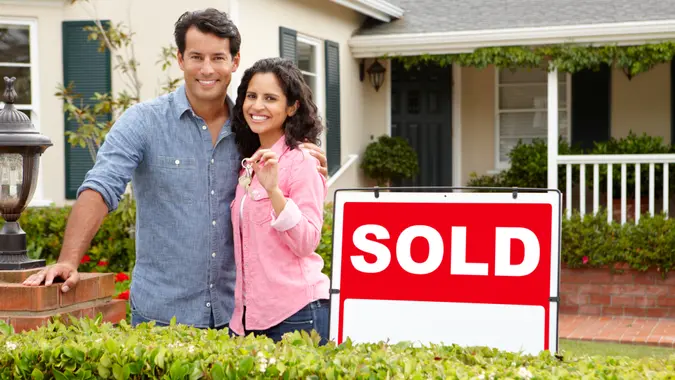Most Millennials Can’t Afford a Median-Priced Home: Will This Situation Ever Improve?

Commitment to Our Readers
GOBankingRates' editorial team is committed to bringing you unbiased reviews and information. We use data-driven methodologies to evaluate financial products and services - our reviews and ratings are not influenced by advertisers. You can read more about our editorial guidelines and our products and services review methodology.

20 Years
Helping You Live Richer

Reviewed
by Experts

Trusted by
Millions of Readers
While the idea of the American dream continues to evolve, most millennials still see owning a home as part of it. A recent Clever Real Estate report found that 74% of millennials think homeownership is part of the American dream, and 62% would consider themselves failures if they never achieved it.
Yet, many millennials are facing barriers in making this dream a reality. According to the report, nearly all millennials (97%) say they face barriers to homeownership, with the most common barrier being cost (52%). And this isn’t just a perception — many millennials really can’t afford homes, with 2 in 3 millennials unable to afford a median-priced home, which Clever Real Estate listed at roughly $420,000.
Here’s a closer look at why many millennials can’t afford homes, and what can be done to improve this reality.
Millennial Homebuyers Face a Number of Obstacles
Finances are the main reason many millennials are not buying homes.
“The biggest barrier to millennial homeownership is that homes are too expensive, with 52% saying high prices prevent them from buying a home,” said Jaime Dunaway-Seale, content writer at Clever Real Estate. “That percentage is up from 46% who said the same in 2024.”
But home prices are not the only obstacle.
“Like high home prices, the other top barriers that stand in the way of millennial homeownership are all financial in nature,” Dunaway-Seale said. “About 46% say high interest rates are a barrier, 44% say saving for a down payment is a barrier and 34% say high property taxes are a barrier.”
Many Millennials Say Boomers Are To Blame for the Affordable Housing Crisis
The report found that one-third of millennials (33%) believe that baby boomers are most responsible for the affordable housing crisis.
“The expensive U.S. housing market is the result of several factors, so it’s unfair to place the blame solely on boomers — but they have contributed in many ways,” Dunaway-Seale said. “We found that more than half of boomers (54%) never plan to sell their home, which has helped fuel the housing shortage and increased the cost of existing properties.
“If boomers do sell, they’re usually downsizing and competing for the same starter homes as millennials,” she continued. “Unfortunately for millennials, boomer offers are often more attractive because the older generation can use the proceeds from their previous home sale to pay in cash or offer over the asking price.”
Will Millennials Ever Be Able To Afford Homes?
The current state of the housing market isn’t doing millennials any favors — and the situation may or may not get better over time.
“It depends — potentially on factors that are beyond millennials’ control,” Dunaway-Seale said. “The current lack of homes has led to higher prices as demand outpaces supply. But if more homes are built, entry-level homes could be easier to find and cheaper to buy.”
In addition to increased inventory, lower interest rates would also help more millennials afford homes.
“Lower interest rates would make monthly payments more affordable for millennials, but that’s controlled by the Federal Reserve, which has kept rates between 6% to 7% for about the past two years,” Dunaway-Seale said.
While these factors are out of millennials’ control, there are steps they can take to make owning a median-priced home more feasible.
“Earning more money through a new job or a raise is the most obvious way to increase purchasing power,” Dunaway-Seale said. “This would allow millennials to save for a down payment or pay down their debt, which will ultimately help them qualify for a loan and get a better rate to make monthly mortgage payments more affordable.”
 Written by
Written by  Edited by
Edited by 
























